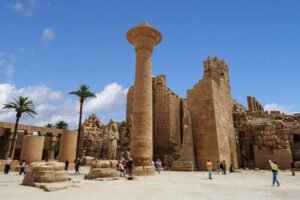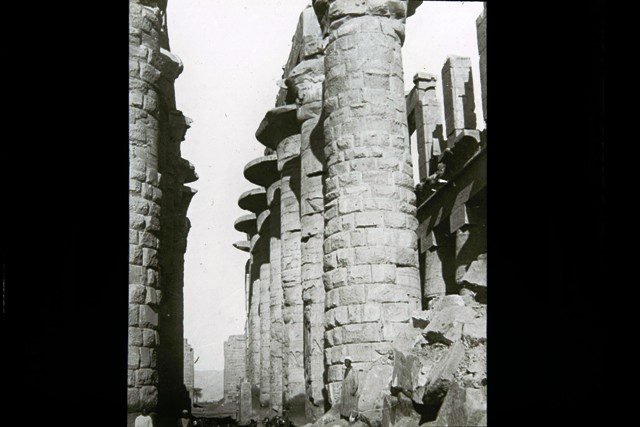Why Karnak Is a Must-Visit in Luxor, Egypt
If you’re planning a trip to Luxor, Egypt, you’ve probably heard about Karnak Temple — and trust me, it’s not overhyped.
Karnak isn’t just a temple; it’s an entire ancient complex that was built and expanded over 2,000 years.
It’s massive, it’s breathtaking, and it tells a story that stretches from the Middle Kingdom to the time of the Romans.
Wandering through its giant pillars and open courtyards feels like stepping into the pages of ancient history.
Whether you’re a fan of ancient civilizations or just looking for something unforgettable — Karnak will blow you away.
What Exactly Is Karnak Temple Luxor Egypt?
Karnak is the largest religious building ever constructed in the ancient world.
It’s not just one temple — it’s a complex of temples, chapels, pylons, and obelisks built by dozens of pharaohs over centuries.
The heart of the complex is the Temple of Amun-Ra, but there are also areas dedicated to Mut (his consort) and Khonsu (his son).
It served as the spiritual center of Thebes, now modern-day Luxor, and was considered one of the most sacred sites in Egypt.
At its peak, Karnak wasn’t just a religious site — it was a city of priests, ceremonies, and royal processions.
Walking through its Hypostyle Hall, with its 134 gigantic columns, is like entering another world.
Even after thousands of years, you can still feel its power.
Where Is the Temple of Karnak Located?
Karnak Temple is located on the east bank of the Nile River in Luxor, just a few kilometers from Luxor Temple.
It’s easily reachable by car, tuk-tuk, or even a pleasant walk if you’re staying nearby.
The exact temple of karnak location makes it part of what was once Thebes — the ancient capital of Upper Egypt.
Coordinates: 25°43′5″N 32°39′29″E
Pro tip: Go early in the morning or around sunset to avoid the heat and crowds.

karnak temple in Luxor
How Far Is Karnak from Luxor?
Karnak is located about 2.5 kilometers (1.5 miles) north of Luxor Temple, which is roughly a 10-minute drive or a 30-minute walk.
You can also take a horse carriage (called a calèche), a fun and traditional way to travel between the two temples.
So if you’re already visiting Luxor, you’re basically next door to one of the greatest archaeological sites in the world.
You could easily visit both Karnak and Luxor temples in one day, though Karnak deserves at least a few hours on its own.
Karnak and Luxor Temples – What’s the Difference?
At first glance, Karnak and Luxor temples might seem similar — but they’re very different in scale and purpose.
Karnak was the main state temple complex used for worship, especially during the New Kingdom period.
Luxor Temple, on the other hand, was more focused on the Opet Festival and linked to royal ceremonies and divine birth.
Key differences:
-
Size: Karnak is much larger — almost like a city.
-
Architecture: Karnak has more pylons, sacred lakes, and chapels.
-
Function: Karnak was a religious center; Luxor had more royal and celebratory purposes.
Many tourists combine karnak and luxor temples in one tour to appreciate how they worked together spiritually and politically.
10 Fascinating Karnak Temple Facts You Didn’t Know
-
Karnak covers over 200 acres — making it one of the largest ancient sites in the world.
-
The Great Hypostyle Hall alone could fit an entire cathedral.
-
Over 30 different pharaohs added to Karnak over time.
-
The columns in the main hall are up to 21 meters (69 feet) tall.
-
It was connected to Luxor Temple via the Avenue of Sphinxes — a 3-kilometer-long sacred road.
-
Many of the original colors on the walls are still visible today.
-
The complex has its own Sacred Lake used for rituals and purification.
-
Obelisks of Hatshepsut and others still stand tall at Karnak.
-
Karnak was still being used in the Greco-Roman period.
-
It’s a UNESCO World Heritage Site as part of the Ancient Thebes area.
These karnak temple facts only scratch the surface — it’s a place full of mystery, grandeur, and hidden meanings.
What to See Inside Karnak Temple
Don’t just walk in and take random photos — here’s what to look out for:
-
First Pylon & Great Court – the massive entrance that sets the tone.
-
Great Hypostyle Hall – the famous forest of 134 columns.
-
Sacred Lake – still reflecting the temple just like ancient times.
-
Temple of Khonsu – dedicated to the moon god.
-
Obelisks of Thutmose I and Hatshepsut – soaring sky-high with inscriptions.
-
Sound & Light Show – held in the evenings with dramatic storytelling.
Every corner is packed with stories, and many are still being uncovered by archaeologists today.
Tips for Visiting Karnak Like a Pro
Here are a few tips to help you make the most of your visit:
-
Go early to avoid both the crowds and the heat.
-
️ Buy tickets at the entrance or online via the Egyptian Ministry of Tourism.
-
Bring water, sunscreen, and a hat — there’s little shade.
-
Hire a local guide or download an audio tour to understand the context.
-
Best time to visit: October to April for cooler weather.
If you’re a photography lover, golden hour (early morning or just before sunset) is pure magic at Karnak.
8. Final Thoughts: Is Karnak Really Worth Visiting?
In one word? Absolutely.
Karnak Temple isn’t just a place to visit — it’s an experience that sticks with you long after you’ve left Luxor.
There’s something powerful about walking the same paths as ancient priests and pharaohs.
It’s a mix of beauty, mystery, and raw history that you can actually feel in the air.
So if you’re coming to Egypt and you skip Karnak, you’re missing out on one of the greatest ancient wonders the world has to offer.






